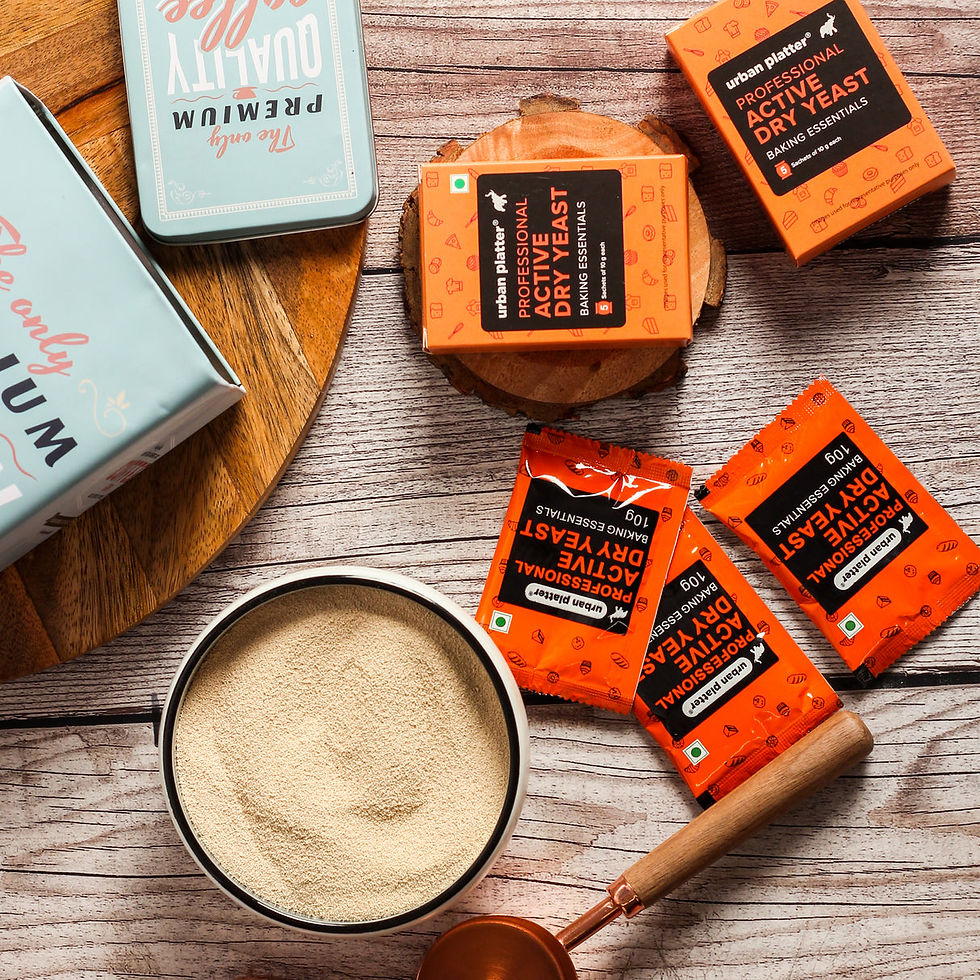Dry Yeast Powder Uses in Indian and International Baking
- urbanplatteronline
- Aug 13
- 4 min read
Dry yeast powder is a baker’s best friend — a small ingredient with big impact. Whether you’re baking a soft loaf of bread, a fluffy pizza base, or a perfectly risen cake, dry yeast works its magic by helping dough rise and develop rich flavor. In both Indian and international baking, it plays an essential role, bridging traditional recipes with modern culinary creativity. Let’s explore its uses, benefits, and the ways it is incorporated in different cuisines.

Understanding Dry Yeast Powder
Dry yeast powder is a dehydrated form of yeast, a type of living microorganism used in baking for centuries. When mixed with water and flour, yeast feeds on the sugars present in the dough, releasing carbon dioxide and ethanol. This process, called fermentation, causes the dough to expand and gain that airy, soft texture we love.
Compared to fresh yeast, dry yeast powder has a longer shelf life, is easy to store, and activates quickly when combined with the right temperature of liquid.
Uses in Indian Baking
While India’s baking culture has grown significantly in recent years, yeast has long been used in certain regional breads and snacks. Some of the most popular uses of dry yeast in Indian recipes include:
1. Pav and Bun Making
Mumbai’s famous pav, found in vada pav, misal pav, and pav bhaji, gets its soft and airy texture from dry yeast fermentation. Similarly, bakery-style buns use yeast for that perfect crumb and mild sweetness.
2. Naan and Kulcha
While traditionally made in tandoors using fermentation from curd or natural starters, modern naan and kulcha recipes often incorporate dry yeast for faster and more consistent rising, especially in commercial kitchens.
3. Pizza Bases
With the popularity of pizza in India, dry yeast powder has become a pantry essential for homemade versions. It gives the base a light, fluffy texture and enhances the flavor.
4. Cakes and Tea Breads
Certain tea breads, fruit cakes, and sweet rolls incorporate yeast to achieve a distinct chewiness and subtle fermented aroma.
5. Regional Delicacies
In Goa and parts of Kerala, yeast-leavened breads like poee and sannas (steamed rice cakes) are traditional favorites where dry yeast can be used for convenience.
Uses in International Baking
Globally, dry yeast powder is indispensable in various baking traditions:
1. Classic Bread Loaves
From French baguettes to Italian ciabatta and American sandwich loaves, yeast is the cornerstone of bread baking. The right fermentation time gives breads their open crumb structure and deep flavor.
2. Pastries and Enriched Breads
Yeast is key in making buttery delights like brioche, Danish pastries, and cinnamon rolls, lending them both volume and a delicate crumb.
3. Artisan Breads
In sourdough-style or rustic breads, dry yeast can be combined with natural starters to enhance rising while maintaining flavor complexity.
4. Bagels and Pretzels
International favorites like chewy bagels and golden-brown pretzels owe their texture to yeast fermentation before they’re boiled or baked.
5. Flatbreads
International variations such as Turkish pide, Middle Eastern pita, and Greek lagana often use yeast for a softer bite and characteristic pocketing.
Tips for Using Dry Yeast Powder Effectively
Check Expiry – Yeast loses potency over time, so always use fresh stock.
Activate Properly – Some dry yeast varieties need to be dissolved in warm water (around 38–40°C) with a pinch of sugar before mixing with flour.
Measure Accurately – Too much yeast can over-ferment dough; too little can result in dense bread.
Control Fermentation Time – Longer fermentation often yields better flavor but requires patience.
Store Correctly – Keep yeast in an airtight container in a cool, dry place, or refrigerate after opening.
Benefits of Using Dry Yeast Powder in Baking
Long Shelf Life – Compared to fresh yeast, it stores well for months.
Consistency – Offers predictable results in recipes.
Convenience – Easy to measure, handle, and transport.
Flavor Development – Aids in creating rich, complex aromas in bread and pastries.
Blending Indian and International Baking
One exciting aspect of modern cooking is the fusion of techniques. Indian home bakers increasingly experiment by blending yeast-leavened breads with Indian spices and fillings. Examples include:
Masala Buns – Pav or dinner rolls flavored with curry leaves, onions, and spices.
Paneer-Stuffed Pizza – Italian base, Indian topping.
Cardamom Buns – Inspired by Scandinavian baking but using Indian cardamom for aroma.
Similarly, international bakers have drawn inspiration from Indian flavors, creating breads infused with turmeric, cumin, and coriander.
Conclusion
Dry yeast powder may be small in quantity, but its impact on texture, taste, and aroma is immense. In India, it has expanded beyond traditional bakery items to home kitchens, enabling bakers to recreate everything from street-style pav to French brioche. Internationally, it remains a backbone of baking culture, used in everything from rustic breads to gourmet pastries.
Whether you are crafting a fluffy pav for Sunday breakfast, kneading pizza dough for a family dinner, or experimenting with artisan loaves, dry yeast powder is the silent partner ensuring your baking success. Mastering its use is the first step toward unlocking a world of culinary possibilities — both at home and across the globe.








Comments